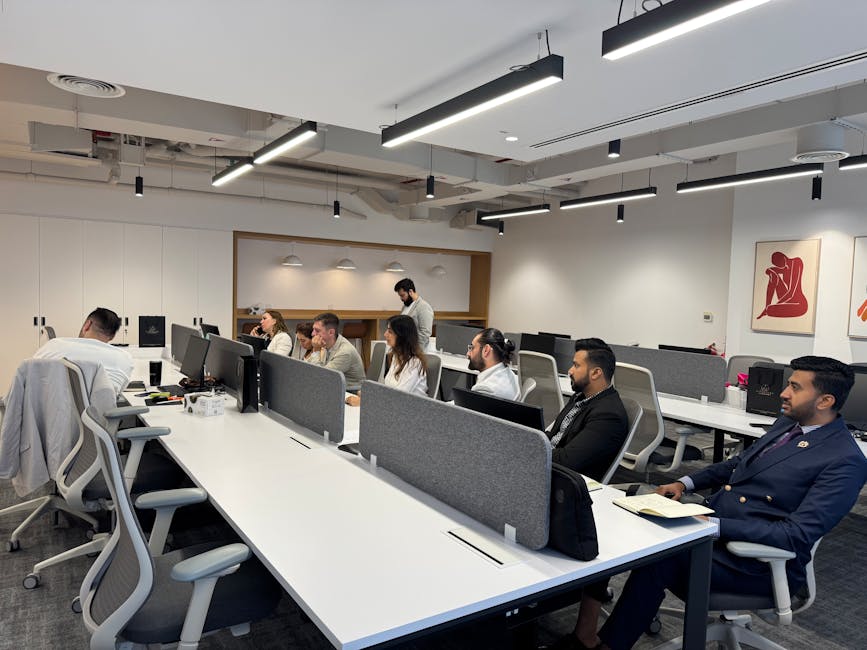Revolutionizing the Workplace: The Benefits and Implementation of Flexible Seating
“Flexible seating is transforming how organizations approach workspace design, offering employees choice and control over their work environment. This article explores the benefits of flexible seating arrangements, implementation strategies, and best practices for creating dynamic, productive workspaces that adapt to diverse work styles and tasks. ”

Revolutionizing the Workplace: The Benefits and Implementation of Flexible Seating
In today's rapidly evolving workplace landscape, organizations are constantly seeking innovative ways to enhance productivity, boost employee satisfaction, and optimize their office spaces. One approach gaining significant traction is flexible seating—a dynamic workspace model that breaks away from traditional assigned desks in favor of a more adaptable environment where employees can choose where and how they work throughout the day.

What Is Flexible Seating?
Flexible seating is a workplace strategy that provides employees with various seating options rather than assigning them to a single, permanent desk. This approach transforms the traditional office into a more dynamic environment where team members can select workspaces that best suit their current tasks, preferences, and work styles.
Unlike the conventional one-desk-per-employee model, flexible seating environments typically offer a variety of workspace options, including:
- Collaborative areas for team projects
- Quiet zones for focused work
- Comfortable lounges for casual meetings
- Standing desks for those who prefer to work on their feet
- Private booths for confidential conversations or video calls
This model recognizes that different tasks require different environments and that employees have varying preferences for how they work most effectively.
The Benefits of Flexible Seating
Enhanced Employee Choice and Empowerment
One of the most significant advantages of flexible seating is the element of choice it provides. When employees can decide where to work based on their current needs, they feel more in control of their work environment. This sense of autonomy can lead to increased job satisfaction and engagement.
According to research on classroom flexible seating (which has parallel applications in the workplace), the majority of participants strongly agreed they enjoyed picking their seat each day, with 54.5% expressing strong agreement in one survey. This positive response to choice translates well to workplace environments.
Improved Collaboration and Communication
Collaborative workspaces become more natural in a flexible seating arrangement. When employees aren't tied to specific areas of the office, cross-departmental interaction increases, breaking down silos and fostering innovation.
"Flexible seating creates natural opportunities for employees from different teams to interact, share ideas, and collaborate on projects that might not have happened in a traditional office layout," explains workplace design expert Sarah Johnson.

Cost Efficiency and Space Optimization
For organizations, flexible seating can lead to significant cost savings through more efficient use of real estate. With the rise of hybrid work models, many companies find their offices underutilized on certain days. Flexible seating allows businesses to reduce their overall footprint while still providing adequate space for employees.
A well-designed flexible seating environment can accommodate more employees in less space without feeling crowded. This office space optimization can result in reduced real estate costs, lower utility expenses, and decreased maintenance requirements.
Adaptability to Changing Needs
The modern workplace must be agile and responsive to changing business needs. Flexible seating creates an environment that can easily adapt to:
- Fluctuating team sizes
- Special projects requiring temporary collaboration
- New work styles and technologies
- Evolving health and safety requirements
This adaptability is particularly valuable in today's unpredictable business climate, where organizations must be ready to pivot quickly.
Implementing Flexible Seating Successfully
While the benefits are compelling, transitioning to a flexible seating arrangement requires careful planning and consideration. Here are key strategies for successful implementation:
1. Assess Your Organization's Readiness
Before making the switch, evaluate whether flexible seating aligns with your company culture, work processes, and employee needs. Consider:
- The nature of your employees' work (Do they need specialized equipment or privacy?)
- Your current technology infrastructure (Can it support mobile working?)
- Your organizational culture (Is it ready for this level of change?)
Not every organization will benefit equally from flexible seating. Understanding your specific context is crucial for success.
2. Invest in the Right Technology
Effective flexible seating requires robust technological support. Essential elements include:
- Reliable wireless connectivity throughout the space
- Cloud-based document storage and collaboration tools for easy access to work materials
- Booking systems for reservable spaces
- Mobile applications that support finding available workspaces
Without the right technology backbone, flexible seating can quickly become frustrating for employees who struggle to find appropriate spaces or access necessary resources.

3. Design Diverse Workspace Options
The key to successful flexible seating is providing a variety of workspace types that support different activities and work styles. Consider including:
- Focus areas: Quiet spaces with acoustic treatments for concentrated work
- Collaboration zones: Open areas with whiteboards, display screens, and comfortable seating for team discussions
- Social spaces: Casual areas that encourage spontaneous interaction and relationship building
- Private spaces: Enclosed rooms or booths for confidential conversations or video calls
- Wellness areas: Spaces that support physical and mental wellbeing
Each area should be thoughtfully designed with appropriate ergonomic furniture and tools to support the intended activities.
4. Establish Clear Guidelines and Protocols
To prevent chaos and ensure equity, develop and communicate clear guidelines for using the flexible seating environment. These might include:
- Clean desk policies (leaving workspaces ready for the next user)
- Reservation systems for certain spaces
- Quiet zone etiquette
- Storage solutions for personal items
- Protocols for finding colleagues
These guidelines help create structure within the flexibility and ensure the system works smoothly for everyone.
5. Provide Training and Support
Don't underestimate the adjustment period required when transitioning to flexible seating. Offer comprehensive training on:
- How to use the new space effectively
- Technology tools that support mobility
- Ergonomic considerations when using different workspaces
- Finding and connecting with colleagues
Ongoing support is also essential, particularly in the early stages of implementation when employees are still adapting to the new environment.
Addressing Common Challenges
While flexible seating offers numerous benefits, it also presents certain challenges that organizations should proactively address:
Personal Space and Belongings
One of the most common concerns employees express about flexible seating is the loss of personal space and a place to store belongings. Address this by:
- Providing secure lockers or digital lockers for personal items
- Creating personalized digital experiences that follow employees throughout the space
- Establishing team neighborhoods where department members can find each other
Balancing Privacy and Collaboration
Finding the right balance between open collaboration and privacy can be challenging. Ensure your flexible seating design includes:
- Sufficient private spaces for confidential work
- Acoustic solutions to manage noise levels
- Visual privacy options for sensitive information
The goal is to create an environment that supports both collaborative and focused work equally well.
Equity and Accessibility
Flexible seating must work for all employees, including those with disabilities or specific needs. Consider:
- Accessibility standards in all space designs
- Priority access systems for employees with specific requirements
- Inclusive design principles that accommodate diverse needs
A truly successful flexible seating environment is one that works for everyone, regardless of their physical abilities or work style preferences.

Case Study: Tech Company Transformation
A mid-sized technology company with 250 employees implemented flexible seating as part of their return-to-office strategy following the pandemic. Their approach included:
- A variety of workspace types, from quiet focus pods to collaborative team areas
- A simple mobile app for finding colleagues and available spaces
- Secure lockers for personal belongings
- Clear guidelines for space usage and cleanliness
The results were impressive:
- 30% reduction in real estate costs
- 85% employee satisfaction with the new arrangement
- 40% increase in cross-departmental collaboration
- 25% improvement in reported productivity
Their success hinged on thorough planning, employee involvement in the design process, and ongoing adjustments based on usage data and feedback.
The Future of Flexible Seating
As workplace management continues to evolve, flexible seating is likely to become even more sophisticated. Emerging trends include:
AI-Powered Space Optimization
Artificial intelligence and machine learning are beginning to play a role in optimizing flexible seating arrangements. These technologies can:
- Predict space needs based on historical usage patterns
- Suggest optimal seating arrangements for specific team projects
- Automatically adjust environmental factors like lighting and temperature based on occupancy
Biophilic and Wellness-Focused Design
Future flexible seating environments will increasingly incorporate biophilic design elements—connecting occupants with nature through plants, natural light, and organic materials. This approach recognizes the impact of the physical environment on wellbeing and productivity.
Hybrid-First Approaches
As hybrid work becomes the norm rather than the exception, flexible seating will evolve to better support employees who split their time between home and office. This might include:
- Enhanced booking systems that coordinate team in-office days
- Technology that creates seamless transitions between home and office work
- Spaces specifically designed for hybrid meetings and collaboration
Conclusion
Flexible seating represents a significant shift in how we think about and use office space. When thoughtfully implemented with consideration for employee needs, technological requirements, and organizational culture, it can transform the workplace into a more dynamic, efficient, and satisfying environment.
The key to success lies in understanding that flexible seating is not simply about removing assigned desks—it's about creating an ecosystem of spaces that support different types of work and preferences. With proper planning, clear communication, and ongoing refinement, flexible seating can help organizations create workplaces that are not just places to work, but environments that enhance productivity, foster collaboration, and adapt to changing needs.
As we continue to navigate the evolving landscape of work, flexible seating offers a promising approach to creating workplaces that truly work for everyone.